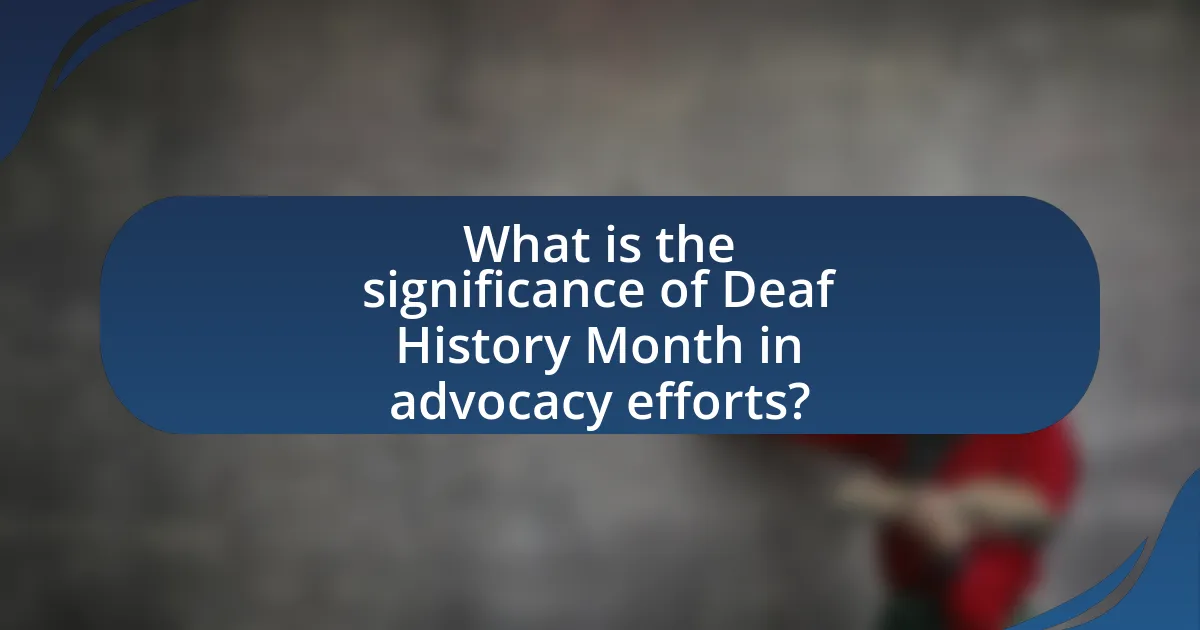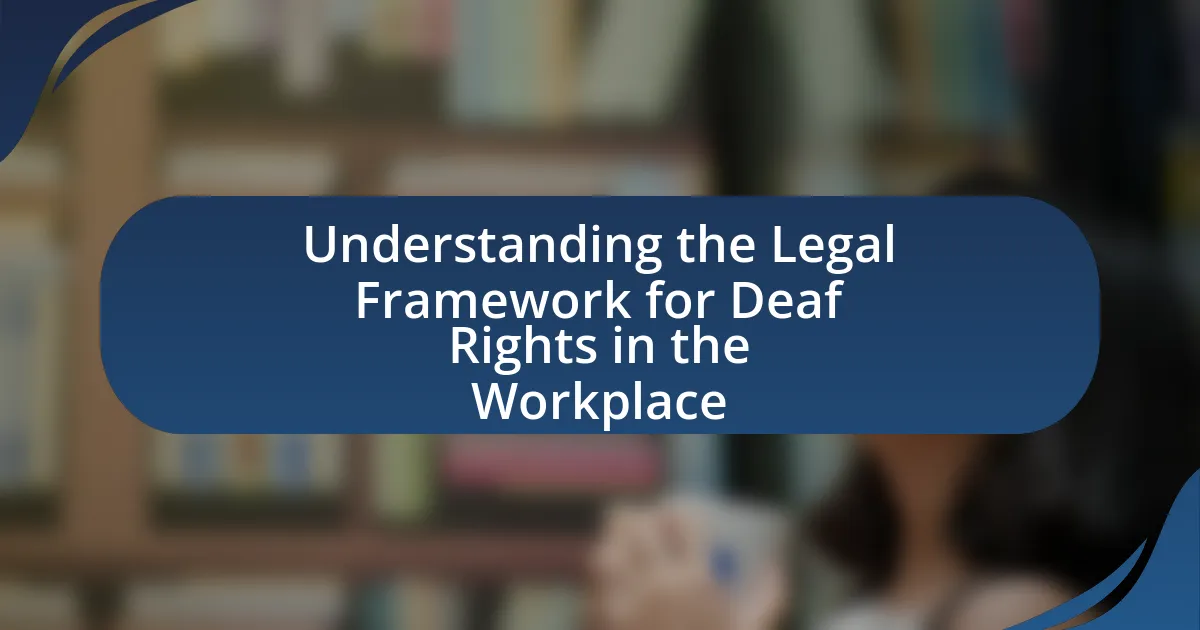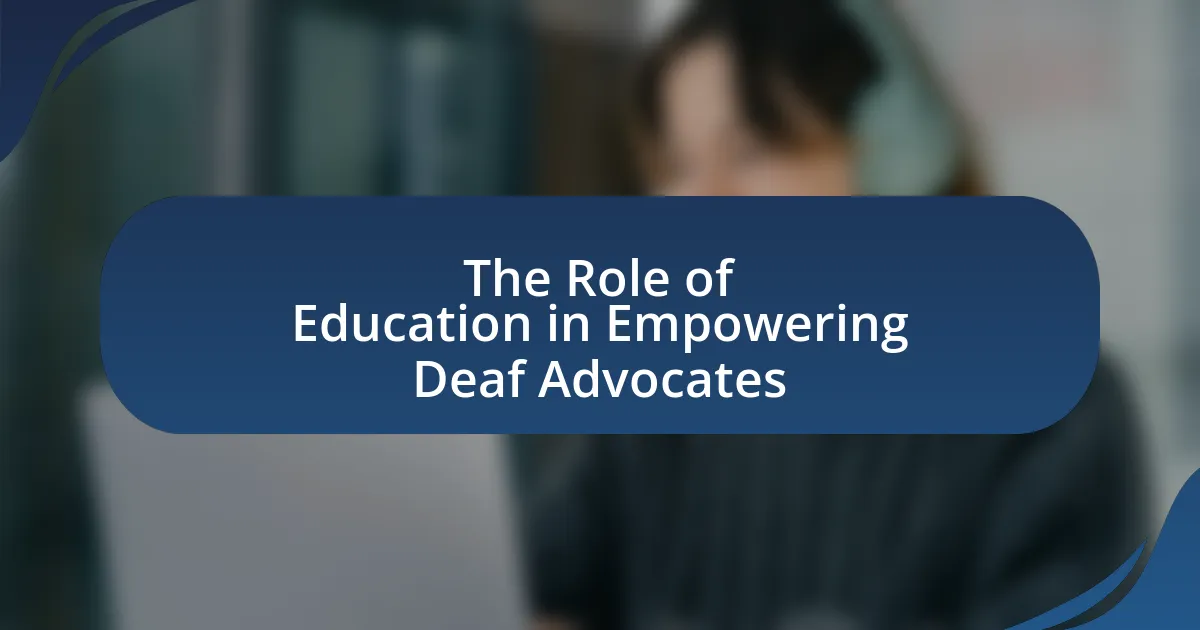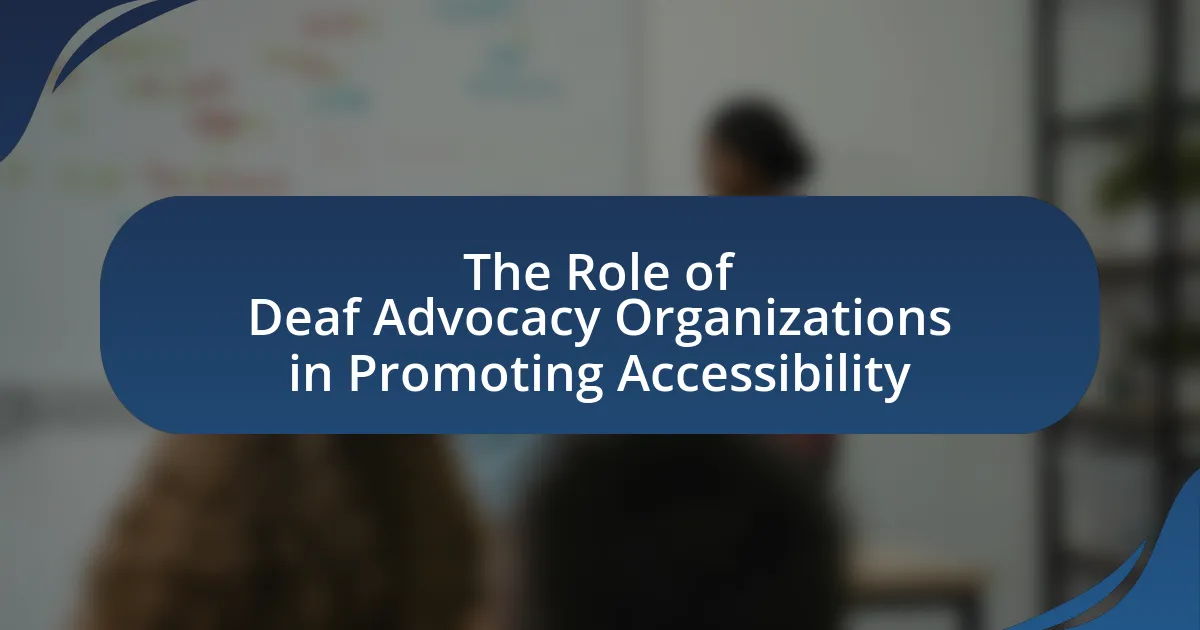Deaf History Month, celebrated annually from March 13 to April 15, plays a crucial role in advocacy efforts by raising awareness of the history, culture, and contributions of the Deaf community. This observance commemorates significant milestones, such as the establishment of Gallaudet University and key events like the Deaf President Now protest, which highlight ongoing advocacy for Deaf rights. The month serves as a platform for promoting discussions on accessibility, education, and equal rights, ultimately fostering social change and inclusion. Through educational initiatives and community events, Deaf History Month enhances understanding and support for the Deaf community, influencing policy changes and addressing current issues such as access to education and employment opportunities.

What is the significance of Deaf History Month in advocacy efforts?
Deaf History Month is significant in advocacy efforts as it raises awareness about the history, culture, and contributions of the Deaf community, fostering greater understanding and support for their rights. Celebrated annually from March 13 to April 15, this month highlights key events and figures in Deaf history, such as the establishment of Gallaudet University and the contributions of Deaf activists. By commemorating these milestones, Deaf History Month serves as a platform for advocacy, encouraging discussions about accessibility, education, and equal rights for Deaf individuals, ultimately promoting social change and inclusion.
Why is Deaf History Month celebrated?
Deaf History Month is celebrated to recognize and honor the contributions and history of the Deaf community. This observance, which takes place from March 13 to April 15, commemorates significant milestones, such as the establishment of Gallaudet University in 1864 and the first Deaf President Now protest in 1988. These events highlight the ongoing advocacy for Deaf rights and awareness, emphasizing the importance of Deaf culture and the need for accessibility and inclusion in society.
What historical events are commemorated during Deaf History Month?
Deaf History Month commemorates several key historical events, including the establishment of the first permanent school for the deaf in the United States in 1817, the founding of the National Association of the Deaf in 1880, and the recognition of American Sign Language as a legitimate language in the 1960s. These events highlight the progress and advocacy efforts within the Deaf community, emphasizing the importance of education, rights, and cultural identity for Deaf individuals.
How does Deaf History Month promote awareness of Deaf culture?
Deaf History Month promotes awareness of Deaf culture by highlighting the contributions and achievements of Deaf individuals throughout history. This observance, celebrated from March 13 to April 15, commemorates key events such as the establishment of Gallaudet University in 1864 and the first Deaf President Now protest in 1988, which are pivotal in advocating for Deaf rights and recognition. By educating the public about these milestones, Deaf History Month fosters a greater understanding of the unique language, traditions, and experiences of the Deaf community, thereby enhancing visibility and appreciation for Deaf culture.
How does Deaf History Month contribute to advocacy?
Deaf History Month contributes to advocacy by raising awareness of the historical and cultural contributions of the Deaf community, which fosters understanding and support for their rights. Celebrated annually from March 13 to April 15, this month highlights key events and figures in Deaf history, such as the establishment of Gallaudet University and the achievements of influential Deaf leaders. By educating the public and policymakers about these contributions, Deaf History Month strengthens advocacy efforts aimed at promoting accessibility, inclusion, and equal rights for Deaf individuals. This awareness is crucial in combating stereotypes and discrimination, ultimately leading to more effective advocacy for legislative changes that benefit the Deaf community.
What role does education play in advocacy during Deaf History Month?
Education plays a crucial role in advocacy during Deaf History Month by raising awareness about the history, culture, and rights of the Deaf community. Through educational programs and initiatives, individuals learn about significant events and figures in Deaf history, such as the establishment of American Sign Language and the impact of the 1880 Milan Conference, which marginalized sign language in education. This knowledge empowers advocates to challenge misconceptions, promote inclusivity, and support policies that protect Deaf rights, such as the Americans with Disabilities Act. By fostering understanding and appreciation of Deaf culture, education serves as a foundation for effective advocacy efforts during this commemorative month.
How can community events during Deaf History Month enhance advocacy efforts?
Community events during Deaf History Month can enhance advocacy efforts by raising awareness and fostering solidarity within the Deaf community and its allies. These events provide a platform for sharing the history, culture, and achievements of Deaf individuals, which can lead to increased visibility and understanding of the issues they face. For instance, educational workshops and panel discussions can inform attendees about the importance of accessibility and the need for policy changes, thereby mobilizing support for advocacy initiatives. Additionally, participation in these events can strengthen community ties, encouraging collective action that amplifies the voices of Deaf individuals in advocating for their rights.
What impact does Deaf History Month have on policy changes?
Deaf History Month significantly influences policy changes by raising awareness of the rights and needs of the Deaf community. This annual observance, celebrated from March 13 to April 15, highlights historical milestones and contributions of Deaf individuals, fostering a greater understanding among policymakers. For instance, the increased visibility during this month has led to legislative initiatives aimed at improving accessibility in education and employment for Deaf individuals, such as the introduction of the 2010 ADA Amendments Act, which expanded protections for individuals with disabilities, including those who are Deaf. Additionally, advocacy efforts during Deaf History Month often result in increased funding for Deaf education programs and resources, demonstrating a direct correlation between awareness campaigns and tangible policy advancements.
How have past advocacy efforts during Deaf History Month influenced legislation?
Past advocacy efforts during Deaf History Month have significantly influenced legislation by raising awareness and promoting the rights of the Deaf community. For instance, campaigns during this month have led to the establishment of laws such as the Americans with Disabilities Act (ADA) of 1990, which prohibits discrimination based on disability and ensures equal access to services for Deaf individuals. Additionally, advocacy initiatives have resulted in increased funding for Deaf education and resources, as seen in the Individuals with Disabilities Education Act (IDEA), which mandates appropriate educational services for all children with disabilities, including those who are Deaf. These legislative changes demonstrate the direct impact of advocacy efforts during Deaf History Month on improving the legal framework supporting the Deaf community.
What current issues are highlighted during Deaf History Month that require advocacy?
Current issues highlighted during Deaf History Month that require advocacy include access to education, employment opportunities, and healthcare services for the Deaf community. Advocacy is essential as many Deaf individuals face barriers in accessing quality education due to a lack of qualified interpreters and resources, which can lead to lower academic achievement. Employment discrimination persists, with Deaf individuals often encountering challenges in hiring processes and workplace accommodations. Additionally, healthcare access remains a critical issue, as communication barriers can hinder effective treatment and patient care. These issues underscore the need for continued advocacy to promote equality and accessibility for the Deaf community.
How can individuals participate in Deaf History Month advocacy?
Individuals can participate in Deaf History Month advocacy by engaging in educational activities, promoting awareness, and supporting Deaf organizations. Educational activities can include attending workshops, lectures, or events that highlight the history and contributions of the Deaf community. Promoting awareness involves sharing information on social media, organizing community events, or displaying Deaf culture in public spaces. Supporting Deaf organizations can be achieved through volunteering, donating, or participating in campaigns that aim to improve the rights and visibility of Deaf individuals. These actions contribute to a broader understanding and appreciation of Deaf history, which is essential for advocacy efforts.
What resources are available for effective advocacy during Deaf History Month?
Effective advocacy during Deaf History Month can utilize resources such as educational materials, community events, and online platforms dedicated to Deaf culture and history. Organizations like the National Association of the Deaf provide toolkits and guides that outline advocacy strategies and historical context. Additionally, social media campaigns and webinars hosted by Deaf advocacy groups offer platforms for sharing stories and raising awareness. These resources are essential for promoting understanding and support for Deaf rights, as evidenced by the increased visibility and engagement during this month-long observance.
How can social media be utilized for advocacy during Deaf History Month?
Social media can be utilized for advocacy during Deaf History Month by raising awareness, sharing educational content, and fostering community engagement. Platforms like Twitter, Instagram, and Facebook allow advocates to disseminate information about the history and contributions of the Deaf community, such as the establishment of American Sign Language and key figures like Helen Keller and Gallaudet. Engaging posts, hashtags like #DeafHistoryMonth, and live discussions can amplify voices and experiences, reaching a broader audience. Research indicates that social media campaigns can significantly increase visibility and support for marginalized communities, making it an effective tool for advocacy during this month.
What are some successful advocacy campaigns linked to Deaf History Month?
Successful advocacy campaigns linked to Deaf History Month include the “Deaf President Now” movement and the “ASL is a Language” campaign. The “Deaf President Now” movement, which took place in 1988, successfully advocated for the appointment of a Deaf president at Gallaudet University, resulting in the election of I. King Jordan. This campaign highlighted the importance of Deaf leadership and representation in educational institutions. The “ASL is a Language” campaign has worked to promote American Sign Language as a legitimate language, advocating for its inclusion in educational curricula and public awareness initiatives. These campaigns have significantly advanced the rights and recognition of the Deaf community, demonstrating the impact of organized advocacy during Deaf History Month.
What best practices can enhance advocacy efforts during Deaf History Month?
To enhance advocacy efforts during Deaf History Month, organizations should prioritize community engagement and education. Engaging the Deaf community through events, workshops, and discussions fosters a sense of belonging and empowerment. Educational initiatives that highlight the history, culture, and contributions of Deaf individuals can raise awareness and promote understanding among the wider public. For instance, utilizing social media campaigns to share stories and historical milestones can effectively reach diverse audiences. Research indicates that increased visibility and representation lead to greater advocacy success, as seen in the rise of Deaf representation in media and politics, which has positively influenced public perception and policy changes.





